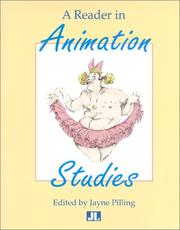| Listing 1 - 9 of 9 |
Sort by
|
Book
ISBN: 9780981471204 Year: 2008 Publisher: sl : Cass Warner Spelling,
Abstract | Keywords | Export | Availability | Bookmark
 Loading...
Loading...Choose an application
- Reference Manager
- EndNote
- RefWorks (Direct export to RefWorks)
Book
Abstract | Keywords | Export | Availability | Bookmark
 Loading...
Loading...Choose an application
- Reference Manager
- EndNote
- RefWorks (Direct export to RefWorks)

ISBN: 0851701264 0851701256 9780851701257 9780851701264 Year: 1983 Publisher: London British Film Institute
Abstract | Keywords | Export | Availability | Bookmark
 Loading...
Loading...Choose an application
- Reference Manager
- EndNote
- RefWorks (Direct export to RefWorks)
film --- filmgeschiedenis --- Verenigde Staten --- 791.43 --- Warner Brothers --- Hollywood --- twintigste eeuw --- thirties --- Warner Bros. Pictures --- History.
Book
ISBN: 9783515110143 Year: 2015 Publisher: Stuttgart Franz Steiner Verlag
Abstract | Keywords | Export | Availability | Bookmark
 Loading...
Loading...Choose an application
- Reference Manager
- EndNote
- RefWorks (Direct export to RefWorks)
Dieterle, Wilhelm --- Dieterle, Wilhelm --- Warner Brothers Pictures --- USA --- (Produktform)Electronic book text --- Geschichte --- Emigration --- Filmarbeit --- Hollywood --- Transatlantische Geschichte --- (VLB-WN)9550
Book
ISBN: 0814271308 0814211178 Year: 2014 Publisher: Columbus : The Ohio State University Press,
Abstract | Keywords | Export | Availability | Bookmark
 Loading...
Loading...Choose an application
- Reference Manager
- EndNote
- RefWorks (Direct export to RefWorks)
English literature --- Fairy tales --- History and criticism. --- Cain, James M. --- Weegee, --- Criticism and interpretation. --- Warner Bros. Pictures (1923-1967) --- History. --- Fairytales --- Children's stories --- Tales --- Weejee, --- Fellig, Arthur, --- Fellig, Arthur H., --- Fellig, Usher, --- Ṿig'i, --- Felig, Artur, --- Felig, Asher, --- פליג, אשר --- Cain, James Mallahan, --- Kʻein, Cheimsŭ M., --- Warner Brothers Pictures (1923-1967) --- Warner Bros. Productions Corp. --- Warner Bros.-First National Picture --- Warner Bros. --- Warner Brothers --- Warner's Features --- Warner Bros.-Seven Arts --- Warner Bros. Inc.
Book
ISBN: 1137406585 1137406577 Year: 2018 Publisher: London : Palgrave Macmillan UK : Imprint: Palgrave Macmillan,
Abstract | Keywords | Export | Availability | Bookmark
 Loading...
Loading...Choose an application
- Reference Manager
- EndNote
- RefWorks (Direct export to RefWorks)
This book offers a different take on the early history of Warner Bros., the studio renowned for introducing talking pictures and developing the gangster film and backstage musical comedy. The focus here is on the studio’s sustained commitment to produce films based on stage plays. This led to the creation of a stock company of talented actors, to the introduction of sound cinema, to the recruitment of leading Broadway stars such as John Barrymore and George Arliss and to films as diverse as The Gold Diggers (1923), The Marriage Circle (1924),Beau Brummel (1924), Disraeli (1929), Lilly Turner (1933), The Petrified Forest (1936) and The Private Lives of Elizabeth and Essex (1939). Even the most crippling effects of the Depression in 1933 did not prevent Warners’ production of films based on stage plays, many being transformed into star vehicles for the likes of Ruth Chatterton, Leslie Howard and Bette Davis.
Culture --- United States --- Motion pictures --- Motion picture acting. --- Theater. --- Cultural and Media Studies. --- American Cinema. --- Screen Performance. --- Film History. --- Theatre and Performance Studies. --- American Culture. --- Study and teaching. --- United States. --- History. --- Film acting --- Moving-picture acting --- Cultural studies --- History and criticism --- Acting --- Motion pictures-United States. --- Motion pictures-History. --- United States-Study and teaching. --- American Cinema and TV. --- Dramatics --- Histrionics --- Professional theater --- Stage --- Theatre --- Performing arts --- Actors --- Motion pictures—United States. --- Motion pictures—History. --- United States—Study and teaching. --- Warner Bros. Pictures (1923-1967) --- California --- Warner Bros.-First National Picture --- Warner Bros. --- Warner Bros. Productions Corp. --- Warner Brothers --- Warner Brothers Pictures (1923-1967) --- Warner Bros.-Seven Arts --- Warner's Features
Book
ISBN: 9780300197600 Year: 2017 Publisher: New Haven London Yale University Press
Abstract | Keywords | Export | Availability | Bookmark
 Loading...
Loading...Choose an application
- Reference Manager
- EndNote
- RefWorks (Direct export to RefWorks)
Behind the scenes at the legendary Warner Brothers film studio, where four immigrant brothers transformed themselves into the moguls and masters of American fantasy Warner Bros charts the rise of an unpromising film studio from its shaky beginnings in the early twentieth century through its ascent to the pinnacle of Hollywood influence and popularity. The Warner Brothers?Harry, Albert, Sam, and Jack?arrived in America as unschooled Jewish immigrants, yet they founded a studio that became the smartest, toughest, and most radical in all of Hollywood. David Thomson provides fascinating and original interpretations of Warner Brothers pictures from the pioneering talkie The Jazz Singer through black-and-white musicals, gangster movies, and such dramatic romances as Casablanca, East of Eden, and Bonnie and Clyde. He recounts the storied exploits of the studio?s larger-than-life stars, among them Al Jolson, James Cagney, Bette Davis, Errol Flynn, Humphrey Bogart, James Dean, Doris Day, and Bugs Bunny. The Warner brothers? cultural impact was so profound, Thomson writes, that their studio became ?one of the enterprises that helped us see there might be an American dream out there.?
Motion picture studios --- Motion picture producers and directors --- Studios de cinéma --- Producteurs et réalisateurs de cinéma --- History --- Biography. --- Histoire --- Biographies --- Warner Bros. Pictures (1923-1967) --- Warner Brothers Pictures, Inc. --- Filmproducers en -regisseurs --- Filmstudios --- Geschiedenis --- Verenigde Staten --- Biografie --- Californie --- Los Angeles (Calif.)

ISBN: 1282359126 9786612359125 0520933141 9780520933149 0520248643 9780520248649 0520248643 9780520248649 9781282359123 6612359129 Year: 2006 Publisher: Berkeley University of California Press
Abstract | Keywords | Export | Availability | Bookmark
 Loading...
Loading...Choose an application
- Reference Manager
- EndNote
- RefWorks (Direct export to RefWorks)
This comprehensive biography of George Gershwin (1898-1937) unravels the myths surrounding one of America's most celebrated composers and establishes the enduring value of his music. Gershwin created some of the most beloved music of the twentieth century and, along with Jerome Kern, Irving Berlin, and Cole Porter, helped make the golden age of Broadway golden. Howard Pollack draws from a wealth of sketches, manuscripts, letters, interviews, books, articles, recordings, films, and other materials-including a large cache of Gershwin scores discovered in a Warner Brothers warehouse in 1982-to create an expansive chronicle of Gershwin's meteoric rise to fame. He also traces Gershwin's powerful presence that, even today, extends from Broadway, jazz clubs, and film scores to symphony halls and opera houses.Pollack's lively narrative describes Gershwin's family, childhood, and education; his early career as a pianist; his friendships and romantic life; his relation to various musical trends; his writings on music; his working methods; and his tragic death at the age of 38. Unlike Kern, Berlin, and Porter, who mostly worked within the confines of Broadway and Hollywood, Gershwin actively sought to cross the boundaries between high and low, and wrote works that crossed over into a realm where art music, jazz, and Broadway met and merged. The author surveys Gershwin's entire oeuvre, from his first surviving compositions to the melodies that his brother and principal collaborator, Ira Gershwin, lyricized after his death. Pollack concludes with an exploration of the performances and critical reception of Gershwin's music over the years, from his time to ours.
Composers --- Gershwin, George, --- Gershvin, Dzh. --- Gershvin, Dzhordzh, --- Gershvin, Jacob, --- Gershwin, G. --- Hershvin, Dz︠h︡ordz︠h︡, --- Gershwin, George, -- 1898-1937.. --- Composers -- United States -- Biography. --- autobiography. --- biographies and memoirs. --- broadway and hollywood. --- classical composer. --- comprehensive biography. --- famous composer. --- golden age of broadway. --- instrumental music. --- jazz clubs. --- jazz. --- music appreciation. --- musical trends. --- performing arts. --- pianist. --- surviving compositions. --- theater. --- tragic death. --- untimely death. --- warner brothers.

ISBN: 9781864620009 1864620005 Year: 1997 Publisher: London : J. Libbey,
Abstract | Keywords | Export | Availability | Bookmark
 Loading...
Loading...Choose an application
- Reference Manager
- EndNote
- RefWorks (Direct export to RefWorks)
Drawing --- Film --- Animation (Cinematography) --- Computer animation --- Congresses. --- ed. by Jayne Pilling --- film --- animatie --- tekenfilm --- computeranimatie --- Quay Brothers --- Oost-Europa --- Quinn Joanna --- Guard Candy --- de Vere Alison --- Fleischer brothers --- klei-animatie --- plasticine-animatie --- Bartosch Barthold --- McLaren Norman --- Engel Jules --- Disney Walt --- Warner brothers --- Japan --- manga's --- Aladdin --- Ren & Stimpy --- Kricfalusi John --- Bacon Francis --- Svankmajer Jan --- Eisenstein Sergei --- Stokes Adrian --- Bakhtin Mikhail --- abstracte film --- Fischerkoesen Hans --- Ferguson Norm --- 791.46 --- Animated films --- Cinematography --- Animated television programs --- Congresses --- Technique
| Listing 1 - 9 of 9 |
Sort by
|

 Search
Search Feedback
Feedback About UniCat
About UniCat  Help
Help News
News